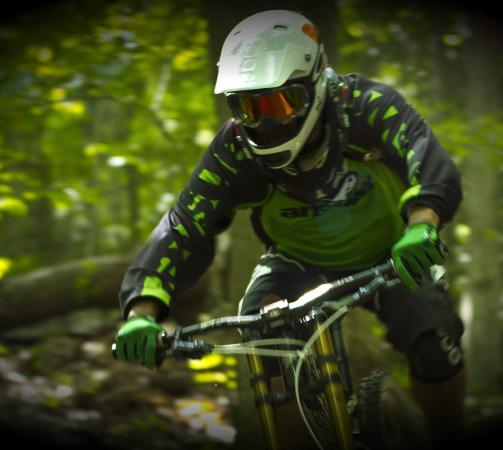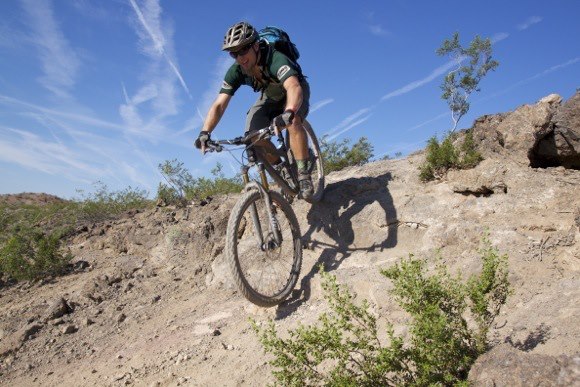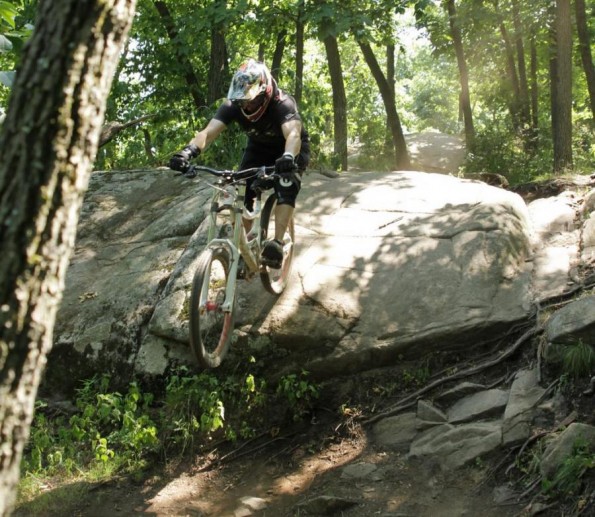When most mountain bikers think of skills they need to learn and practice, braking isn’t usually one of them. I mean, how tough can it be: pull the lever and your stop, right?
Actually, it’s a lot more complicated than that. If you take the time to learn how to brake properly, it can do wonders for your riding, giving you more control and actually making you faster.

Brake Position
Before you even start learning how to brake properly, it’s very important to have your brake levers in the right position. When in the attack position (out of the saddle, weight forward, chest low) your wrists should be directly in line with your your forearms, your braking fingers, and your brake levers. There shouldn’t be an awkward bend in your wrist; it should be a natural, straight line. For more on bike fit, check out this article.
Use Both Brakes
Many beginning mountain bikers probably had an unfortunate incident on the mountain bike trail when they grabbed a big handful of front brake and flipped over the bars. As a result, they’ve just decided to never use the front brake and rely solely on the rear brake to control their speed and stop the bike.

When it comes to control and stopping power, avoiding the front brake is about the worst thing you can possibly do. When descending, which is generally when you need to brake, most of the rider’s weight is toward the front of the bike, and the force of the rider’s weight and gravity pulling the bike and rider down the hill puts a lot of force into the front wheel. Consequently, the front brake contains 70% of total braking power and the rear brake only has about 30%.
Don’t believe me? Here’s a little experiment for you to try: go out to a grassy slope and set up a start line which you will coast from, and a line where you will start braking. On your first pass, coast from the start line and start braking at the brake line with your rear brake only. Mark where you finally come to a stop. Repeat this same procedure with just the front brake (being careful not to endo), and then finally with both brakes at the same time.
You’ll find that with just the front brake you were able to stop in a much shorter time than you could with just the rear brake; with both brakes you’ll stop even more quickly.

The moral of the story: for maximum stopping power, use both brakes. Yeah, using just the front brake is a recipe for disaster, but if you use the rear brake along with the front brake you will find, with practice, the rear brake balances the front out, making for an extremely controlled braking experience.
Avoid Skidding by Modulating Your Braking Power
The second biggest mistake I see a lot of new riders making is skidding. For some reason, a lot of newbies think that a skid is the absolute fastest way to stop a bike, when in fact skidding is about the worst thing you can do. Yes, I already said using just the rear brake was the worst, but most of the time when riders use only the rear brake it devolves into a skid anyway.

Skidding is bad for several reasons:
- You don’t stop as fast as you could otherwise
- You don’t have as much control
- It accelerates trail erosion
You don’t stop as fast when skidding because, in order to slow down, you need to slow the rotation of the wheels. When you skid, the entire wheel rotation stops, locking up and dragging in the dirt. This actually takes longer to stop than not locking the wheel and maintaining a controlled braking process. You can do a test on a gravel road similar to the one mentioned above to see this in action.
Secondly, when the wheel locks up and starts sliding, you lose control of the bike. It starts to wash side to side and bounce over trail obstacles instead of traveling in a straight, controlled line.
While the third point doesn’t have much to do with performance, please strive to leave no trace when mountain biking.
So, in order to prevent skidding, simply don’t lock up the rear brake. Most modern brakes feature great modulation, meaning that the harder you squeeze the lever, the more power you apply. Don’t think of the brakes as an on/off switch; instead, think of them as providing a range of braking power. Instead of simply grabbing the lever as hard as possible, squeeze it gently and feel the pads engage as you add pressure, and disengage slightly as you let pressure off. With practice, you should be able to learn exactly how much braking force you need in order to stop in a given situation.
Brake with One Finger
Two-finger braking is a holdover from the days of weak rim brakes that would get gunked up with mud and slick with water. Those old brakes had a fraction of the stopping power modern hydraulic disc brakes have. Even modern-day mechanical disk brakes have significantly more power than the Y or canti brakes of yore.

Since even the most basic disc brakes offer respectable stopping power, you should really only ever have one finger on the brake lever (either your forefinger or middle finger, it’s up to you). I have heard passionate arguments for both fingers and, logically, the middle finger argument has a lot of merits to it. But personally, I find it much more comfortable and natural to brake with my index finger. Last year I tried to train myself to use my middle finger to brake, and while I got to the point that I could do it regularly, I eventually just reverted back to the index finger. Most of the people I ride with use their index fingers too, so if that feels most comfortable and natural for you, I say go for it.
Once you decide which finger to use, adjust your brake levers so that when you are in attack position, your chosen finger lands right in the crook on the end of the lever. Having your finger out on the end will keep it from sliding around and provides the greatest mechanical advantage for maximum power and control.
Brake Before the Corners, Not in Them
One mistake I personally find myself making a lot of times, even when I know I shouldn’t, is braking in the corners. In an ideal world, you should strive to brake before the corners and not while you are actually in them.

There are many reasons for this, but the main one is that braking in the corners reduces bike control, especially if the wheels wash out.
Instead of trying to slow down while cornering, try braking before the corner. This takes practice, but reduce your speed before entering the corner so you can navigate the corner confidently without having to brake while actually in the corner. This will allow you to focus on your cornering technique and will provide your tires with the maximum amount of traction possible.
Additionally, when done correctly, you will generally accelerate through the turn, exiting the turn at a faster rate of speed than you entered it. This is especially true for bermed corners.
If you do accidentally enter a corner at high speed, this is one of the few times when you should not use your front brake. Using your front brake in the corner is a great way to cause your front tire to wash out and start sliding. Front tire slides are very difficult to control and recover from, so avoid them at all costs.
Instead, if you absolutely must brake in a corner, use your rear brake. Avoid skidding, but if your rear wheel does break loose, it’s much easier to control a rear tire slide than a front tire slide.

Don’t Brake Too Much
Finally, don’t use your brakes too much. Most riders don’t have an issue with staying off the brakes when the going is smooth, but when the trail gets rough many inexperienced riders tend to grab a handful of brake and slow way down.
As I wrote in an article on Loving the Bike a couple of days ago: “When riding technical terrain, speed is your friend. The faster your wheels spin, the more gyroscopic force the spokes generate. Basically, a fast-spinning wheel wants to stay upright, but a slower-spinning wheel is much easier to tip over.”
Here’s a quick experiment you can do on your own to see this in action:
- Take the front wheel off of your bike.
- Hold it by the QR skewer (or through axle) with one hand on each side.
- Roll it very slowly along the ground and then pick it up.
- As it spins, tilt it side to side in the air and feel how much resistance (if any) there is.
- Now roll the wheel quickly along the ground so that it starts spinning very fast, and then pick it up.
- As it spins, tilt it side to side in the air and feel how much more resistance there is when you try to tilt the wheel. You should find that it is very difficult to do, and that the spinning wheel wants to stay upright.
The same principles hold true out on the singletrack. If you are descending a rough, technical trail littered with rocks, roots, and drops, it is going to be much easier for you to be knocked off balance if you are moving slowly than if you are moving rapidly.
Of course, you should always ride in control, but when you are out there trying to push the limits just a little bit more, think about this principle. Try easing off on the brakes and pinning it through the gnar, and you may be surprised at how easy your nemesis rock garden actually is!

Conclusion
Some of these braking tips are very basic, and others are more complex and counter-intuitive. However, if you take the time to practice these skills and make them second nature, your speed will go up and your control over the bike will increase dramatically!
Your Turn: What do you struggle with most when braking?





















43 Comments
Feb 20, 2013
"Trail braking" is a useful technique too. Basically you ease off the brakes as you enter the corner. That way you're braking as late as possible, but still have maximum traction available to corner. It's tough to get the timing just right though, so I try and be off the brakes before going into the corner.
We have a little time trial series here in town, and the trail is short and very tight and twisty, so good bike handling skills are paramount if you wanna go fast. Braking before the corners, and not IN the corners, results in smoother riding, more control, faster corner exit speeds, and much faster lap times. The stop watch does not lie!
All that said, it's something I have to constantly remind myself of.
Feb 21, 2013
Feb 21, 2013
Feb 13, 2015
\
.\
..\ -
...\ -
....\_
Feb 21, 2013
Feb 21, 2013
I bet doing some fine-tuning of your brake levers will make a world of difference all by itself!
Feb 21, 2013
Feb 22, 2013
Feb 22, 2013
Feb 21, 2013
Index finger is it for me. I did have some temporary issues adjusting the lever on the Avid's so that they didn't pinch my other fingers, but switching to Shimanos took care of the problem.
Mar 2, 2013
Mar 18, 2013
Mar 30, 2014
Nov 25, 2013
Feb 20, 2013
Feb 20, 2013
Feb 20, 2013
Feb 21, 2013
Feb 21, 2013
Feb 21, 2013
Feb 21, 2013
Feb 21, 2013
Feb 21, 2013
Feb 21, 2013
Feb 21, 2013
Feb 21, 2013
Feb 21, 2013
Thanks, glad you enjoyed it!
Feb 20, 2013
Actually, all great stuff and I know from experience every bit of it works. Except, I've never been able to get my levers adjusted to the point I can use just my index without the lever hitting my knuckle on my middle before fully engaging the brake. Looks like I need to fiddle a bit more.
Feb 21, 2013
Re: Lever hitting knuckles: most brake models should have an adjustment for that. I was having this issue with some XO brakes last summer, but there was a screw down near where the lever reaches the main reservoir that could adjust it.
Feb 22, 2013
Feb 20, 2013
Feb 21, 2013
Feb 21, 2013
With my old-school bike with "canti" brakes, sometimes the brakes used to get wet. That was when I had to sometime end up doing the "death grip" just to slow things down enough. Even then I used to only used 2 fingers.
The new disc brakes now-a-days are so much more powerful and modulate so well. Smooth, finessed braking is so much easier to control, and all I need now is 1 finger.
I swapped the brake levers with the shifters (grips, shifters, brakes). I also adjusted the levers so that I can easily reach to grab them with my index fingers.
Feb 21, 2013
Feb 23, 2013
Aug 2, 2013
Aug 2, 2013
Feb 21, 2013
My larger challenge is what to do when I realize too late that I've got too much speed for the corner. Lately I've been twisting my upper body toward a tight turn and it seems to help get through the turn a little quicker and safer.
Feb 22, 2013
When you find yourself coming in too hot, the best thing to do is get your center of gravity (CG) as low as possible. Get your weight off the seat and onto your feet and pedals. This, coupled with the gyroscopic effect, will help reduce the possibility of crashing. Keep the inside pedal as high as possible, and the outside pedal low, again, keeping as much weight as possible on your feet and not on the seat or bars. Keeping your CG low and back will reduce the likelihood of your rear tire coming up and over your head.
While doing that, squeeze (never grab) the brakes as close to the point of locking up the tires as possible. This will compress the suspension, helping to lower your CG even more, set your springs to absorb bumps/rocks/dips better, and more importantly, slow you down.
All the while look where you want the bike to be going, turn in, keep even pressure on the bars, and keep your weight low and inside the turn. Keeping the wheels rolling (not locking them up and skidding) will help in the even that either tire starts to wash out on you. If the rear decides to step out, control it with your feet and legs, putting pressure on the outside leg pushing inwards to help keep it from looping around you.
If the front starts to wash out, again, this is not a life ending situation (though, if there is a cliff, maybe you should have been going slower to begin with). Resist the urge to yank the bars further in to the turn, as this will cause the wheel to dig in, bite into the dirt, stop rolling, and then catapult you over the bars. Keeping the tire turned where you want it will be your best bet, as is keeping the front tire rolling.
Speed, momentum, and the gyroscopic effect are all GOOD things to keep on your side in the case of entering a turn too hot. Search for videos of motorcycle high side accidents to see what happens if someone chops, or cuts, the throttle while in a slide. You want to keep things rolling and moving, while controlling the lack of static friction between the tires and trail.
Typing this all is one thing, doing it is another. It becomes second nature after a while, which is to your benefit. The best thing to do is look ahead on the trail, adjust speed, stance, trail position, and other variable accordingly, and anticipate as much as possible. When you can't do that, resist the urge to grab as much front and rear brake as possible and skid to a halt, and attempt to control the slightly out of control ride through the turn until you scrub off enough speed to exit the turn safely.
Feb 22, 2013
Feb 13, 2015
I hope you can imagine from this quick picture. (the corner is going left)
\
\
\ .
\ -
\_-
Feb 21, 2013
Now adding to what Greg was saying about too much rear brake. In a straight line the center of gravity lies between the front and rear wheel. When braking the center of gravity migrates forward, you feel this as a compression of the front suspension, and an extension of the rear. Add to that the front wheel tends to gain traction and friction, while the rear looses. Seeing the rear is "light" and the center of gravity is behind the front wheel, there is a tendency of the mass wanting to get in front of the friction (object in motion tends to stay in motion). Thus a swap of ends tends to follow. This is why when braking moving your center of gravity back, by forcing the bike in front of you a bit, aids traction in the rear, making sure to be aware that the rear is not locking.
Another bad thing about braking that some are not aware of. Some suspension designs tend not to work well while the wheel is locked.. It tends to apply torque and prevent free movement of suspension (further diminishing traction).
Feb 21, 2013